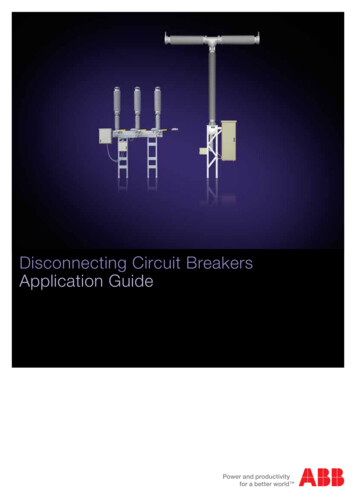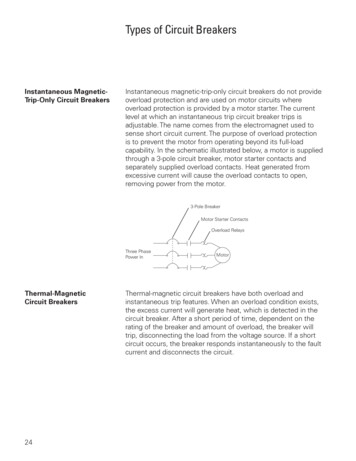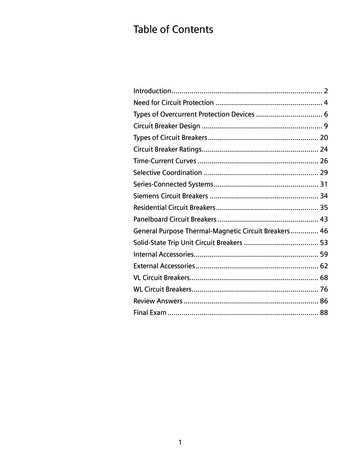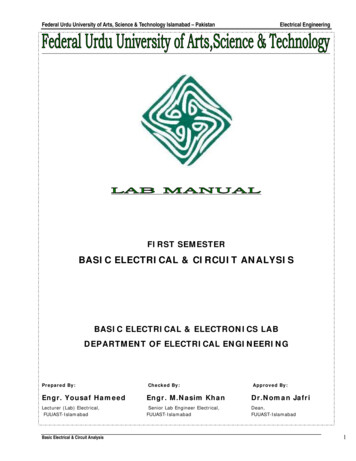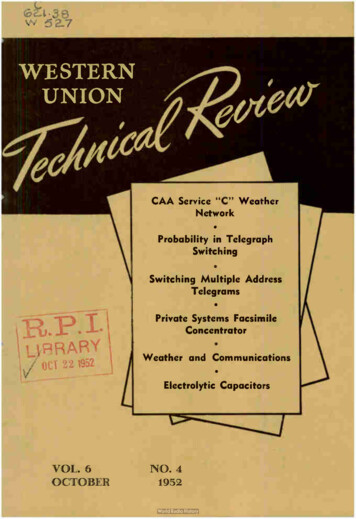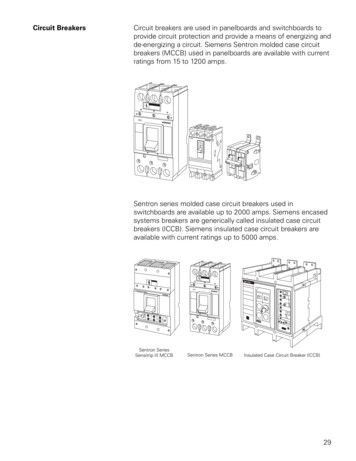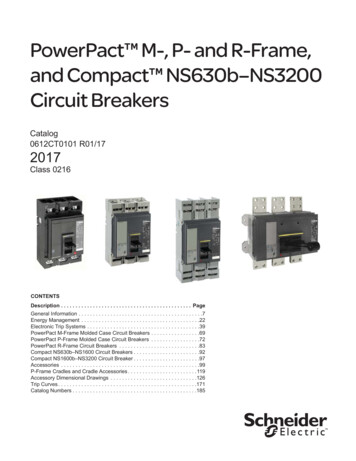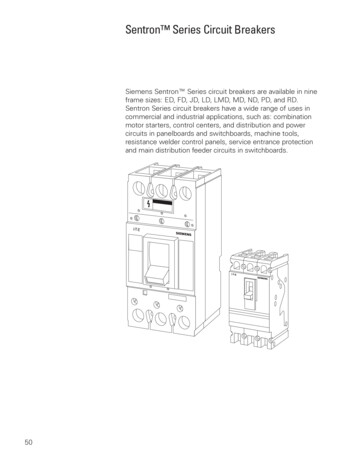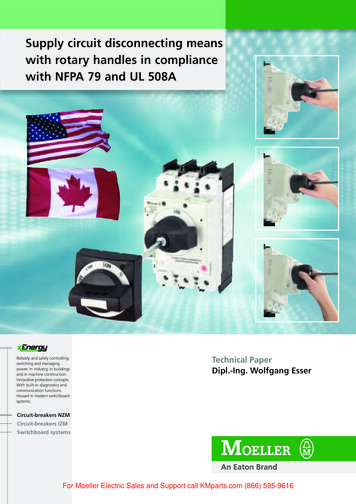
Transcription
Supply circuit disconnecting meanswith rotary handles in compliancewith NFPA 79 and UL 508AReliably and safely controlling,switching and managingpower. In industry, in buildingsand in machine construction.Innovative protection concepts.With built-in diagnostics andcommunication functions.Housed in modern switchboardsystems.Technical PaperDipl.-Ing. Wolfgang EsserCircuit-breakers NZMCircuit-breakers IZMSwitchboard systemsFor Moeller Electric Sales and Support call KMparts.com (866) 595-9616
Supply circuit disconnecting meanswith rotary handles in compliancewith NFPA 79 and UL 508A– Fulfilling key requirements of relevant North American standards –AbstractDifferences between IEC and NorthAmerican standards already becomeapparent when discussing even themost basic of component accessories,such as the operating handle of asupply circuit disconnecting switch. Forexample, main disconnect switchesequipped with door mounted rotaryhandles, and installed in industrialcontrol panels for industrial machineryapplications, essentially require the useof an additional internally mountedsupplemetary handle in order to meetall of the requirements found in therelevant North American standardsdealing with this application. Animportant change in an earlier (2002)edition of the NFPA 79 standard forindustrial machinery panels led to thissignificant development. It became anessential requirement of the standardat that time for an operating handle tomaintain contact with the disconnectswitch at all times, regardless of doorposition.Furthermore, in cases where the mainswitch needed to be accessed internallyand switched on by qualified persons,let’s say for maintenance purposes, thestandard already required, under itsdoor interlocking provisions, that adeliberate action initially be performedby such persons before the disconnectswitch could be engaged successfully, inorder to enhance the inherent safety ofpersonnel and of the assembly. Thus, anadditional level of sophistication for theinternal supplemetary handle, combinedwith a door mounted rotary stylehandle, became necessary in order tomeet all of the requirements of therelevant standards in this respect.Moeller now supplies such supplementary handles, which feature a deliberateaction consisting of a travel of thehandle to a certain position, followedby a simultaneous push and turn ofthe handle through to the ON position.The handle has all the necessarycertifications, and is now part of thecomponent program. This paper willaddress in more detail the ramifications2of this development in North Americanstandards as well as provide potentialend-users with various solutions tomeet the requirements.IntroductionIn the IEC world the rotary handle is thepopular choice, and it’s by far the mostwidely encountered type of operatinghandle for main disconnect switches inthese various countries. In the US andCanada, the situation is markedlydifferent, and the use of similar rotaryhandles for main disconnect switchapplications is not nearly as prevalent,chiefly due to the fact that the conventionally door mounted operatinghandle separates from the switch whenthe door is opened, and this featureis considered less than desirable.Countless millions of rotary handles inIEC countries throughout the world arethus located on the outer door portionof a control panel when the door isopen, and that is perceived as aproblem in North America, since it isalleged to potentially invite theactuation of the switch mounted insidewithout the use of a proper handle.However, that was only a theoreticalproblem, since Moeller, for many years,had been offering a supplementaryhandle that mounted directly onto theextension shaft and the body of theswitch inside the panel. The supplementary handles Type NZM.-XDZ havealways been available for the purposeof providing qualified persons with ameans to actuate the switch from insidethe control panel without the use of atool. (Photo 1). The bar is, however, seteven higher in these cases by currentNFPA 79 [1] und UL 508A [2] standardsbecause, in the event that the door ofa control panel housing the maindisconnect switch has been opened, thestandards mandate that an additionaland premeditated action (DeliberateAction 1) on the part of a qualifiedperson be required in order to effect a1will be described in more detail in the paperchange in the operational state of theswitch from OFF to ON. Although thisrequirement of the NFPA 79 standarddirectly impacts significant designaspects of the operating handle of asupply circuit disconnecting means usedin electrical control panels for industrialmachinery, particularly those involvingIEC style door mounted rotary handles,its primary goal naturally is not to makecomponent design more difficult, butrather to provide industry floorpersonnel with an extra measure ofprotection from electric shock throughthe use of suitable enclosures,specifically the need for adequateinterlocking provisions with the supplydisconnecting means whenever there isthe potential for exposure to liveequipment.The new supplementary handles TypeNZM -XHB-DA(R)-NA from Moellerfulfill all of the more stringent NorthAmerican standards requirements inthis respect. They can also be used in alltypes of control panel applicationsextending beyond those solely relatedto industrial machinery. Their usagewould, of course, also provide anadditional measure of safety in start-upand maintenance situations for anyinstallation in the IEC world usingswitches with door mounted rotaryhandles. The supplementary handlescan be used on all NZM circuit breakers,(P)N switch-disconnectors and NSmolded case switches, whether or notthese products are being used as asupply circuit disconnecting means inany given application.IEC compliant solutions are notalways sufficient to meet allrequirements in North AmericaThis author has dealt extensively withthe topic of „Export of electricalcomponents and systems to NorthAmerica“ by giving comprehensiveseminars and writing several detailedtechnical papers on the lications/index.jsp). OneFor Moeller Electric Sales and Support call KMparts.com (866) 595-9616
Mounting PlateThe switch rotarymechanism insidethe enclosure ispadlockable.SupplementaryHandleDoor couplerDoor opens in Reset handleposition onlyExtension shaftThe supplementary handle inside theenclosure is permanently screwed ontothe extension shaftThe door mounted rotary handle,with door interlocking provision,is padlockablePhoto 1: Former solution with older version supplementary handle, lockable rotary switch mechanismand lockable door mountedhandle.recurring theme in all of these endeavors has been that widely applied andaccepted technical solutions rooted incomprehensive and well establishedIEC standards are often consideredinadequate when going up againstcomparable North American requirements, specifically those from relevantNFPA installation standards auch as theNEC2 and CEC3, as well as in various ULand CSA safety standards dealing withproduct and engineered assemblyapprovals. In many instances, thesedifferences can cause conflicts andhardships to arise during localinspections of products at the end-userfacility, or whenever power is requiredfor the start-up and commissioningphases of a new project or refurbishedinstallation.This paper deals mainly with theoperating handles of circuit breakers,switch-disconnectors and Molded CaseSwitches [3], which would be used asthe supply circuit disconnecting meansof electrical control panels for industrialmachinery per the NFPA 79 standard.These switches are normally operatedfrom the exterior of the control panel,with the panels doors closed. The23NEC NFPA 70 National Electrical Code, USACEC Canadian Electrical Code, Kanadaswitches themselves are mountedinternally and their operating shaftsextend through the door, all the whilemaintaining the necessary environmental rating of the outer handle andenclosure assembly. The operatinghandles are mounted on the door panelexterior. Moeller refers to this style ofswitch operator as a „door-mountedrotary handle“. A coupling pieceenables the opening and closing ofthe control panel door, either with orwithout any dependence on theposition of the main contacts. Anelaborate offering of additional handlesand accessory parts are available as wellin order to fulfill a number of specialapplication requirements. StandardNorth American versionIEC versionHandle positions“ON”“TRIPPED”IEC-Door: “Interlocked ornot essedinsulatingmaterialscrewused todefeat thedoor interlockingfeature(defeatmechanism)Photo 2: IEC style Door mounted rotary handles feature 3 switching positions whereasNorth American versions have 4. The North American versions allow the door to openwhen the handle is rotated through an overtravel, to a position slightly beyond OFF. Theword „Reset“ is located at that position. The word „Reset“ further indicates that, after atrip, the handle needs to be first brought back to the OFF position before the switch canbe re-closed.For Moeller Electric Sales and Support call KMparts.com (866) 595-96163
Operating handle modification possibilities for molded case circuit breakers and switches Type NZM, N, NS, PNTypeDoor interlockingPadlocking capabilityis activated, when handle closes switchPadlocking on handle only when door isclosed.Padlocking on switch is possible also withdoor open.Door opening in positionsPadlocking in positionsalso in ONonly in OFFonly OFFON OFFonly in OFFNZM.XTVDV(-60)(-0)wT -mHH SNZM.XTVDVR(-60)(-0)wT --H SNZM.XTVDV(-60)(-0)-NAwT- -H SNZM.XTVDVR(-60)(-0)-NAwT- -H SIEC-Door mounted rotary handlesNA-Door mounted rotary handles normal- not possibleS on SwitchH on HandlemH modification on Handle possibleOnly OFF Door can be opened when handle is turned beyond the OFF position.wT defeatable with the use of a ToolTable 1: The table shows door interlocking and padlocking capabilities of handles and switches as they are supplied from the factory,along with various field modification possibilities.operating handles come in black, withred-yellow versions for Emergency-OFFapplications, as well as operatinghandles with or without defeatingmechanisms (Table 1), and handles withenvironmental ratings to cover both IECand UL/CSA type rated requirements.IEC type operators are dual position(ON and OFF) handles and, if applicable,include a third position (Trip) as dictatedby the type of switch. These modelsalso have UL/CSA certification. Controlpanel doors equipped with IEC styledoor mounted rotary handles with abuilt-in door interlocking feature canbe readily opened as soon as the switchis in the OFF position, whereas specialNorth American versions of the samestyle handles require a slightly extendedtravel beyond OFF in order to releasethe mechanism and allow the door toopen. (Photo 2).North American standards are verymuch application based. Thus, it’salways a good idea to keep theIndustrial MachineryNEC Art. 670NEC (NFPA 70)NFPA 79Leading electricalRequirements for the electrical and electronicstandard for Industrialequipment of industrial machineryMachineryEletrical design requirements for machinery control panelsDesign of Industrial Control Panels per UL 508APart 1:General Use PanelsApplications:Part 2:Specific Use Panels . . . .Sec. 65 MachineryDoor interlocking,operation independent of door position „DeliberateAction“and additionalrequirementsin UL508AandNFPA 79only inNFPA 79Photo 3: The main disconnect switch requirements described in this paper deal primarilywith electrical control panels suitable for industrial machinery applications per UL 508Aand NFPA 79. Of course, these features can also be incorporated in any other type ofindustrial control panel assembly.4application in mind when considering aparticular design or solution to anyparticular engineering task. As such,there may not always be a need toconsider the special requirements of a“supply circuit disconnecting means” toa panel. This paper deals mostly withelectrical apparatus for industrialmachinery, which is considered to be aspecific use application per thestandards. Article 670 of the NEC (NFPA70) defers the details of this applicationto the specialized standard NFPA 79„Electrical Standard for IndustrialMachinery“ (Photo 3). There is also thepredominant UL standard to considerfor the design and building of “listed”(3rd party certified) industrial controlpanels, i.e. UL 508A. The UL 508Astandard, accordingly, differentiatesbetween “General Use IndustrialControl Panels” in Part 1, and “ SpecificUse Industrial Control Panels” in Part 2.The electrical controls for machines(Industrial Machinery) are covered asSpecific Use Industrial Control Panels insections 65 through 67 of the UL 508Astandard. The standard acts more orless as a supplement in this regard tothe NFPA 79 standard, which describesall the critical and relevant requirements for machine control in muchgreater detail. The following mainthemes covered in this paper: Switches with rotary operatinghandles, Door interlocking provisions, Padlocking capabilities,For Moeller Electric Sales and Support call KMparts.com (866) 595-9616
IEC and UL/CSA (NEMA) operating handle environmental ratings for molded case circuit breakers and switches Type NZM, N, NS, PNTypeEnvironmental RatingIEC / EN - UL / CSAHandlecolorIEC- Door mounted rotary handlesCharacteristicsDoor interlocking possible only in yellow marked fields*) in ON, the door interlock can be defeated with theuse of a toolThe door interlock cannot be defeated, if the handleis padlocked off.Door opens in OFF- Position *)NZM.XTVDV(-60)(-0)IP 66UL / CSA Type 12 4XblackPadlockable on handle and switch.NZM.XTVDVR(-60)(-0)IP 66UL / CSA Type 12 4XredPadlockable on handle and switch.Door opens only when handle is turned beyondthe OFF-position *)NA- Door mounted rotary handlesNZM.XTVDV(-60)(-0)-NAIP 66UL / CSA Type 12 4XblackPadlockable on handle and switch.NZM.XTVDVR(-60)(-0)-NAIP 66UL / CSA Type 12 4XredPadlockable on handle and switch.Table 2: Operating handle variations with their corresponding North American environmental ratings. Particular attention to door interlocking and padlocking requirements in North America for operating handles is warranted. All operating handles are UL listed and CSAcertified. The NA versions of the door mounted rotary handles are the preferred choice for North American applications. The IEC versions of the door mounted rotary handles in the NA market place are tolerated for the most part. Actuation of the switch independentof the door position, and finally: „Deliberate Action“are essentially concepts which are morerelevant and appropriate when discussing the requirements of a supplycircuit disconnecting means forindustrial machinery, and are notnecessarily applicable to the topic ofmain disconnect switches for generalapplications. The special features of theType NZM -XTVDV-DZV6Panel sidewall with door open.Door needs to be hinged on opposite side.supplementary handle, to be describedin greater detail later in the paper, alsolend themselves well to both IEC andNorth American applications extendingbeyond the requirements of any specificusage standard.There are, furthermore, „General Use“and additional „Specific Use“ industrialcontrol panels per UL 508A for whichthe concept of a deliberate action, as itrelates to interlocking provisions forindustrial machinery, is not specificallymentioned as a requirement. (Table 2).One could, therefore, legitimately andwith good conscience, make use ofother well proven operator accessoriesfor these applications, such as the sideand rear operated handles (Photo 4)for circuit breakers and molded caseswitches. Even though, as part of theirbasic design aspects, these handles donot separate and always maintaincontact with the switch, they wouldnot, on their own, be suitable forindustrial machinery applications, sincethey do not inherently provide for therequired “deliberate action” which ispart of the interlocking provisionrequirements for this application. Inthese cases, one should at least plan toinclude an electrical interlock as part ofthe design.Panel sidewall or back plate.Photo 4: Switches with side mounted rotary mechanisms (left) or with rear operation(right) are suitable in this form for all types of Industrial Control Panels per UL 508A, butnot specifically for industrial machinery on their own. Depending on the application,additional electrical interlocking circuitry could be necessary to fulfill all requirements.Photo 5: Typical North American enclosurewith a flange mount and opening on theside to allow for “vertical motion” handles.For Moeller Electric Sales and Support call KMparts.com (866) 595-96165
4xBowden cable between handle and switchPhoto 6: The vertical motion handle (right) depicts the typical North American main disconnect switch handle which, independent of the door position, remains in contact withthe switch. The use of flexible, Bowden cable solutions is more often encountered incontrol panel applications. The handle and enclosure also combine to mechanically interlock with the door.Switch operation per North AmericanconventionsA particular aspect of North Americanstyle main disconnect switches is thatthe switch operating means or handlealways remains in physical contact withthe switch, independent of any doorposition. Although this had been theconvention throughout many years, ittook on added significance when itbecame part of the requirementoutlined in the main electrical standardfor industrial machinery (NFPA 79) in2002. It became apparent that the newrequirement clearly posed potentiallyserious acceptability problems fortypical door mounted rotary handlescommonly seen and used in IEC styleapplications world-wide. The standardsdon’t spell out any specific solution.One of the main requirements simplystates that the supply circuitdisconnecting means must remainoperable at all times to qualifiedpersons, independent of the doorposition4, without the use of a specialaccessory tools or devices. Thisconvention peculiar to North America ispartly realized through the use ofspecially designed enclosures featuringa flange portion on the front sidewallsurface of the enclosure (Photo 5),which is designed to accommodate orlink with typical North American sidemounted vertical motion or “flangemounted” handles (Photo 6). These46UL 508A: Par. 66.6.3; NFPA 79: Parts 5.3.3.1.5,5.3.4.2.1, 5.3.4.2.3types of handles are not very wellknown in Europe and are consideredrather unconventional there as well asin other IEC countries. As mentioned,they feature a vertical operationalmotion. These relatively large andmechanically robust handles are eithermechanically linked directly with theswitch or come attached to the switchvia a flexible Bowden type cableassembly tied to a sliding mechanismdesigned to actuate the switch toggleoperator. This latter solution allowsmore flexibility in terms of positioningthe switch inside a panel assemblywhereas the direct mechanical link ofthe former would require the switch tobe placed more closely to the flangeopening side of the enclosure.Regardless of whether the controlpanel door is open or closed,operational access to the switch for ONand OFF operations is theoreticallymaintained at all times, and that’s themain purpose of the design.The Vertical Motion Handlesadditionally provide a mechanicalinterlocking feature with a single ormulti-door control panel, either directlyor with the use of additionalmechanical enclosure provisions. As ageneral rule, incoming supply circuitdisconnect switches should only beable to be switched ON once allcontrol panel doors have beenclosed, and door interlockingprovisions have been activated.US and Canadian standards allowqualified persons to temporarily bypassthe door interlocking feature of acontrol panel by actuating, with the useof a prescribed tool, a manufacturersupplied defeat mechanism normallyprovided on the operating handles ofswitches used as the supply circuitdisconnecting means. A condition forthis, however, is that the defeatmechanism is fully de-activated and theinterlocking provision becomes automatically re-instated once all of thecontrol panel doors have beenreclosed5. The handles must also havea padlocking feature to be in fullcompliance with the NEC and OSHAstandards. Per UL 508A Section30.4.4 and NFPA 79 section 5.3.3.1.36the operating handle of thedisconnecting means must be capableof being locked in the „OFF“ or openposition.As previously described, it is allowed forqualified persons, with the use of aproper tool, to gain access to the insideof a panel with the main switch in theON position and thus under live conditions. An appropriate tool to use forthe defeater mechanism could be, forexample, a particular screwdriveridentified by the manufacturer as beingsuitable for the purpose. The ability towork without removing power hasmany practical advantages such astroubleshooting a faulty circuit andmaking necessary adjustments toprotective devices. It will later bedescribed in greater detail howqualified persons, by undertaking adeliberate action, are also able to closea main disconnect switch with thecontrol panel door open in order to reestablish power in a panel.Comprehensive testing of verticalmotion handles, Bowden cables andswitches from various brands havedemonstrated that their usage in theIEC world would not be permitted, forthe mere fact that a successful outcomeof critical performance testing of theactuator mechanism on present designsper the IEC standard (IEC / EN 60 947[4]) could not be verified. Moeller doesoffer this style of operator because oftheir strategic importance on the NorthAmerican market, but only undercondition that they be installed in NorthAmerica only. The handles do not bear56UL 508A: Par. 66.1.5.1; NFPA 79: Par. 6.2.3.2For brevity purposes, the paper references theUS norms only.For Moeller Electric Sales and Support call KMparts.com (866) 595-9616
Industrial Control Panels in accordance with UL 508APart 1Part 2GeneralUse PanelsSpecific Use PanelsGeneralUseIndustrialMachineryNEC complianceXXSuitable enclosure environmental ratingXXAmbient temperatureconsiderationsXX- / O *)X-/OXMain Disconnect switch /padlockable door- / O **)XMain Disconnect switchsupplementary handlewith Deliberate Action-/OX ***)Door interlock defeatmechanism-/OOAutomatic re-activationof door interlock-/OXDeliberate Action-/OXControl circuit transformer-/OXEnclosure lighting provisions up to 150V, on loador line side of Main Disconnect-/OOPanel rating labelXXPanel rating label designation: „Industrial Control Panel for industrialMachinery“,largest heating load-XLabel (e.g. from UL) toconform with NECXXDoor interlockingElevator AddiControltionalTypes(in coordinationwith NFPA79)Features/Characteristics/RequirementsMain Disconnect switchCraneControlRefer to UL 508Afor additional SpecificUse type Panels additional requirementsConstruction inaccordance with UL508A, Section .65 - 6768 - 721- 6180Refer toStandard62 - 641 - 61X RequiredO Optional- not a requirement, not applicable*) Refer to UL 508A, 30.3 / 60.1 **) Refer to UL 508A, 30.4 ***) Applicable to door mounted rotary handlesTable 3: The requirements for various types of industrial control panels per UL 508A arenot always completely identical. The most comprehensive requirements are generallyassociated to industrial control panels for industrial machinery, which are in line withNFPA 79, the US national electrical standard for industrial machinery.the CE mark7. Technical information incatalogs and accompanyingdocumentation also refer to theseapplication constraints. A re-import intothe IEC world would not be permissible.In the afore-mentioned test per IEC / EN60 947 to verify the operational performance of the actuator mechanism,the main contacts of a switch arepurposely welded closed and underthese conditions, it is strictly forbiddenfor the operating mechanism of theswitch to be physically brought into theOFF or OPEN position and allow theinstallation of a padlock. The reasoningbehind the IEC standard makes perfectsense from a safety point of view. If apadlock were to be installed in the OFFposition of the operator under theseconditions, an unsuspecting user couldbe easily be fooled into concluding thatthe circuit on the load side of thewelded switch would be open, when itis in effect live. A comparableperformance test in North Americanstandards to verify the suitability of anactuating mechanism in this respect isnot currently in place.Machine manufacturers and panelbuilders, who normally work inaccordance with IEC and EN standards,also have misgivings about incorporating vertical motion handlesinto their assemblies, and wouldnormally only do so under theexpressed wishes of their NorthAmerican customers. Panel builderswho deal in export markets looktowards the implementation ofsolutions which would ideally haveglobal conformity. Under this prerequisite, it’s not realistically possible tounify a design based on the use of avertical motion handle. Even the NorthAmerican automotive industry,arguably the most prominent user ofthis type of handle historically, hasalready started giving signals that itmay be seriously re-considering the useof this relatively expensive operator intheir own future installations in favor ofa more globally accepted and modernapproach. Their reasoning relates aswell to the overall theme of enhancedsafety in the workplace and theinfluence of a union based workforce,which is still an integral part of thisindustry in North America.7Conformité Européenne, the CE mark allowsproducts so marked unimpeded access tomarkets within the European Union.For Moeller Electric Sales and Support call KMparts.com (866) 595-96167
Fulfilling North Americanrequirements with rotary handleequipped disconnect switchesThere really isn’t much chance in theforeseeable future to expect a unifiedapproach in the North American marketplace with respect to the selection ofeither vertical motion or rotary handlesfor use with main disconnect switches.The UL 508A standard for industrialcontrol panels does allow both designsin all applications as long as they meetapplicable requirements and followproper conventions with respect to OFFand ON handle positions.In the introduction we touched uponthe Moeller supplementary handle TypeNZM -XDZ, which fits onto the switchextension shaft inside the panel and hasbeen available for many years now. Thistime proven accessory, as well as themore recent version Type NZM.XTVDV-DZV6-NA to be described next,need to be permanently attached ontothe extension shaft in order to meet theprovisions of the UL 508A (par. 66.6.3)and NFPA 79 (sect. 5.3.3.1.5) whichrequire the operating mechanism to bereadily operable 8 without the use ofaccessory tools or devices, i.e. articleswhich could otherwise normally be partof tool kits carried by qualified personsperforming maintenance duties. Bothof these solutions from Moeller,therefore, took into consideration theneed under this context for the maindisconnect switch to be operable usingtwo separate handles. The primaryhandle is mounted on the panel doorexterior and provides the requiredfunctionality with the panel doorclosed, whereas the supplementaryhandle, which is mounted on the switchextension shaft, is accessible to operatethe switch whenever the door is open.Whether the older or more recentversion of the supplementary handle isused, Moeller still equips the rotarymechanism of the switch itself, which ispart of the switch housing inside thepanel, with a padlocking feature. Thisprovides the switch with a permanentmeans to be locked in the OFF position,independent of the door position, andthus fulfills an important requirementof the NFPA 79 standard (sect.5.3.3.1.3) with respect to devicessuitable for use as the supply circuitdisconnecting means. The feature88UL 508A, Pkt. 66.6.3.A, NFPA 79, Punkte5.3.3.1.3, 5.3.3.1.5effectively helps to safeguard againstinadvertent closing of the maindisconnect switch when the controlpanel is open. As mentioned, thepadlockable switch rotary mechanismmounts on the switch housing insidethe panel. In order to simplify orderingprocedures, this rotary mechanism isbundled together with the extensionshaft and supplementary handle as partof a kit, which is made available underone part number. The rotary mechanismalso features a clearly visible means toindicate switch position when thecontrol panel door is open, which isalso part of the requirements. The threemain aspects combining both featuresand requirements, i.e.: Operational capability, Switch position indication, and Padlocking featurecan be achieved in both sets of handleswhen all parts and switch combinationsare selected appropriately, and thusfulfill an important premise of thestandard that the main disconnect bereadily accessible at all times toqualified persons, independent of thedoor position.As long as a control panel is equippedwith a single door only, the interlockingprovisions of the UL 508A and NFPA 79standards can be easily fulifilledmechanically with various configura-tions of door mounted rotary handles(Table 3). All UL/CSA certified IEC stylemodels of door mounted rotaryhandles, also those for use with IECversion of circuit breakers and moldedcase switches, feature 3 distinct switchposition indications: ON TRIP and OFF.In the ON position the handlemechanically interlocks with the doorand in the OFF position allows the doorto open. As previously mentioned, theNorth American version of the handle,with the suffix „-NA“, features anadditional 4th position (Photo 2). Inorder to reach this position, the handlehas to be rotated through a slightovertravel beyond the OFF position.Only in this position does the handlecompletely release the interlock anda
panels, i.e. UL 508A. The UL 508A standard, accordingly, differentiates between "General Use Industrial Control Panels" in Part 1, and " Specific Use Industrial Control Panels" in Part 2. The electrical controls for machines (Industrial Machinery) are covered as Specific Use Industrial Control Panels in sections 65 through 67 of the UL .
